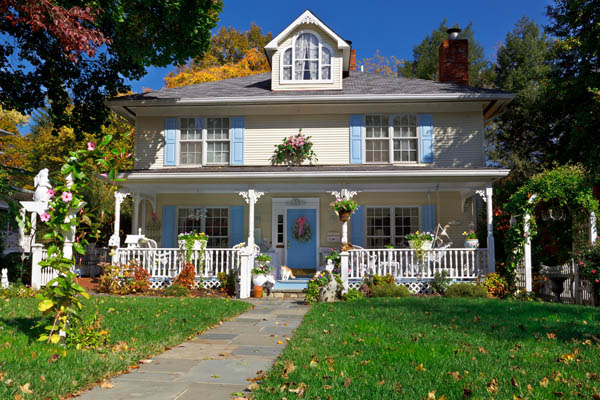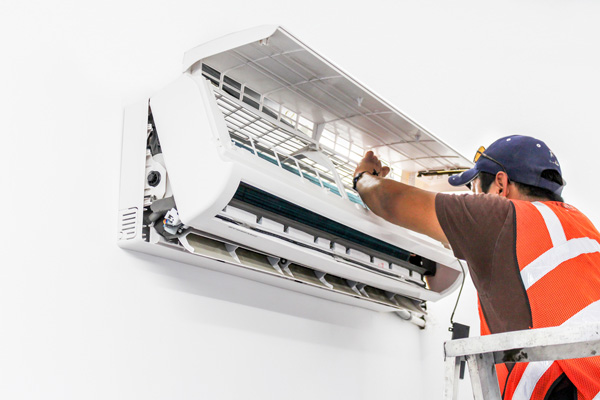Contents

Historic homes are not built in a way that allows the installation of today’s air conditioning systems easily. Although many of the older homes that still stand to this day are properly maintained, the layout of their design is not always as accommodating to modern air conditioning systems. Most historic homes also do not have a network of ducts built into the structure. Furthermore, installing ductwork is often not an option. Ductwork installation is a major project, and it could affect the aesthetics of a historic home.
Another challenge that historic homes present is the condition of the insulation present. Older insulation materials may not meet current standards of safety and reliability. Some may even pose a risk to health. Thankfully, there is an excellent solution that will work remarkably well with a historic home – the ductless air conditioning system. It can provide energy-efficient comfort while preserving the aesthetic value of your historic home.
Understanding Ductless Mini-Split Systems
A ductless mini-split system is one of the most popular types of HVAC systems. It offers independent temperature control for multiple rooms or zones. A mini-split system consists of an evaporator or indoor air handler and a condenser or outdoor compressor. These connect via a conduit. The number of air handling units present in one home will depend on the number of zones it has.
Benefits Of Ductless Air Conditioners
Many older homes are cooled by ductless mini-splits. Here are just a few reasons why ductless HVAC systems are beneficial for your historic home.
Energy Efficient
HVAC ductwork is not perfect. In fact, an estimated 25% of the energy used by the HVAC system is lost through the network of ducts. If you choose window ACs, on the other hand, they may not be as efficient in cooling an older home. Window ACs are also notoriously costly to operate. Meanwhile, compressors on ductless models are inverter-based, which means the units can speed up or slow down based on the prevailing conditions in a zone or area. With conventional HVAC compressors, the system has to shut down before it starts up again. Startups consume more energy, which means you will be spending more on conventional HVAC systems than on ductless AC systems.
Ductless mini-splits can also be turned off if a zone or room is unoccupied. That way, you do not need to use energy to cool a room that is empty. Central cooling units do not have this feature.
Maintaining Indoor Air Quality
Ductless systems use multi-stage air filters to eliminate particulates from the air. Since ductless systems do not require ductwork, there is no component that will collect dust, dander, pollen, and other particles that could be trapped in the ducts. Ducted systems typically release these pollutants into the indoor air through the vents, severely reducing the quality of the air. Window air conditioners also do not offer the perfect solution because these often promote the growth of mold, mildew, and bacteria. With ductless systems, this is not a concern at all.
Creating Temperature Zones
Zones are rooms or areas that are grouped together so they can be maintained at a specific temperature. Each zone can have a different temperature from other zones. This is a feature that makes ductless mini-splits stand out and is advantageous for large historic homes that require different temperature settings for different rooms or areas. The kitchen area, for example, can have a lower temperature compared to the bedrooms. When different temperature settings can be applied to different zones, residents and visitors of historic homes can enjoy optimal comfort.
Whisper-Quiet Operation
One of the key features that make a ductless system perfect for historic homes is its whisper-quiet operation. Thanks to small tubes in the indoor units that distribute conditioned air, ductless systems can run for hours without producing the annoying humming sounds that other types of HVAC systems are known for. Ducted systems, for example, generate loud noises due to the large ductwork component while window type ACs are rather noticeable while in operation. The lack of insulation also contributes to the noise problem.
Easy Ductless Installation
Ask any HVAC technician, and they are likely to agree that ductless systems are very easy to install. Ductless installation is fairly quick and easy, requiring just a small hole drilled through the wall to connect indoor and outdoor units. Central ACs, on the other hand, requires major work and construction on top of ductwork installation.

Environment-Friendly
Ductless AC systems consume less energy compared to conventional AC systems and window-type ACs. This makes them far more environmentally friendly. Installing a ductless AC for a historic home allows you to ensure indoor comfort and reduce your carbon footprint.
Reduced Heating & Cooling Costs
Energy-efficient systems help lower your energy consumption. Of course, the cost of energy that you will ultimately pay for will depend on the model and size of the system, but since ductless types can be programmed to cool only zones that are occupied, they consume less energy. Plus, ductless systems enjoy higher SEER ratings, with some models having the highest ratings for air conditioning systems that are currently available.

Will A Ductless AC System Change A Historic Home’s Structure?
Ductless air conditioners do not need ductwork to distribute conditioned air. The most that your HVAC contractor will do is drill a three-inch hole through a wall to accommodate the conduit for the indoor and outdoor units. Ductless systems do not require drastic changes to the structure of a home, which means a historic home basically stays intact. There is no need to worry about tearing down ceilings and walls to install large, bulky components. They are also compact-sized, which means they can be installed in small spaces.
Can Window ACs Offer The Same Quality As Ductless Air Conditioners?
It may be tempting to think that window ACs are a good alternative to ductless mini-splits. Unfortunately, window-type ACs may not be the answer to your cooling needs. As functional as they are, they also come with a number of disadvantages. To install one window AC unit, you will have to create a hole on a wall the same size as the body of the AC. If you have a window that matches the size of the unit, you could probably install it there. However, having an AC unit installed on a window of a historic home essentially leaves that window open to burglars and pests. Even a tiny crack or gap can leave the structure vulnerable. Plus, window ACs are rather noisy and increase the risk of mold and mildew growth. Furthermo0re, they have exceptionally high operating costs.
Conclusion
Historic homes are valuable pieces of our past. They should be maintained and preserved to keep their value and beauty to be appreciated by generations to come. Keeping a historic home cool can be a challenge, but it can be done in a way that does not damage the structure but retains its aesthetic value. Therefore, if you have a historic home that needs a safe and effective cooling system, consider talking to your trusted HVAC contractor about ductless systems.
How Wilcox Energy Can Help You

Wilcox Energy is one of the leading heating and cooling service companies in the region. Our NATE-certified technicians have the training and experience in a wide range of HVAC services, including installations, tune-ups, repairs, and replacements.
We know how valuable historic homes are and we understand what it takes to ensure that it is preserved and maintained in the best way possible. We provide you with the best solutions for your needs and ensure that we work together to meet the highest standards of comfort, energy efficiency, safety, and indoor air quality. Call Wilcox Energy today to schedule your in-home estimate at no cost.
For more information about our HVAC services, be sure to contact Wilcox Energy. You can click here to contact us, or you can call us at (860) 399-6218 to find out more. We offer a full line of heating and cooling repairs, maintenance services, and installations.
